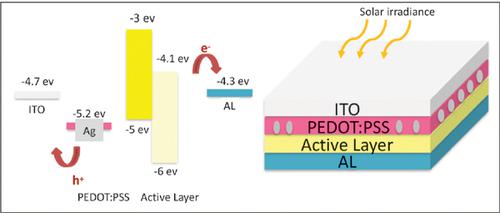Current Nanoscience ( IF 1.5 ) Pub Date : 2020-07-31 , DOI: 10.2174/1573413715666190125163438 Asma Khalil 1 , Zubair Ahmad 2 , Farid Touati 1 , Mohamed Masmoudi 3

|
Background: The photo-absorption and light trapping through the different layers of the organic solar cell structures are a growing concern now-a-days as it affects dramatically the overall efficiency of the cells. In fact, selecting the right material combination is a key factor in increasing the efficiency in the layers. In addition to good absorption properties, insertion of nanostructures has been proved in recent researches to affect significantly the light trapping inside the organic solar cell. All these factors are determined to expand the absorption spectrum and tailor it to a wider spectrum.
Objective: The purpose of this investigation is to explore the consequence of the incorporation of the Ag nanostructures, with different sizes and structures, on the photo absorption of the organic BHJ thin films.
Methods: Through a three-dimensional Maxwell solver software, Lumerical FDTD, a simulation and comparison of the optical absorption of the three famous organic materials blends poly(3- hexylthiophene): phenyl C71 butyric acid methyl ester (P3HT:PCBM), poly[N-9″-heptadecanyl-2,7- carbazole-alt-5,5-(4′,7′-di-2-thienyl-2′,1′,3′-benzothiadiazole)]: phenyl C71 butyric acid methyl ester (PCDTBT:PCBM) and poly[2,6-(4,4-bis-(2-ethylhexyl)-4H-cyclopenta[2,1-b;3,4-b′]dithiophene)-alt- 4,7-(2,1,3-benzothiadiazole)]: phenyl C71 butyric acid methyl ester (PCDPDTBT:PCBM) has been conducted. Furthermore, FDTD simulation study of the incorporation of nanoparticles structures with different sizes, in different locations and concentrations through a bulk heterojunction organic solar cell structure has also been performed.
Results: It has been demonstrated that embedding nanostructures in different locations of the cell, specifically in the active layer and the hole transporting layer had a considerable effect of widening the absorption spectrum and increasing the short circuit current. The effect of incorporation the nanostructures in the active layer has been proved to be greater than in the HTL. Furthermore, the comparison results showed that, PCDTBT:PCBM is no more advantageous over P3HT:PCBM and PCPDTBT:PCBM, and P3HT:PCBM took the lead and showed better performance in terms of absorption spectrum and short circuit current value.
Conclusion: This work revealed the significant effect of size, location and concentration of the Ag nanostructures while incorporated in the organic solar cell. In fact, embedding nanostructures in the solar cell widen the absorption spectrum and increases the short circuit current, this result has been proven to be significant only when the nanostructures are inserted in the active layer following specific dimensions and structures.
中文翻译:

Ag纳米结构增强聚合物BHJ薄膜的光吸收:模拟研究
背景:通过有机太阳能电池结构不同层的光吸收和光捕获如今已成为人们日益关注的问题,因为它极大地影响了电池的整体效率。实际上,选择正确的材料组合是提高层效率的关键因素。除了良好的吸收性能外,最近的研究还证明了纳米结构的插入会显着影响有机太阳能电池内部的光捕获。确定所有这些因素以扩大吸收光谱并将其调整为更宽的光谱。
目的:本研究的目的是探讨掺入不同尺寸和结构的银纳米结构对有机BHJ薄膜的光吸收的影响。
方法:通过三维Maxwell求解器软件Lumerical FDTD,对三种著名的有机材料共聚(3-己基噻吩):苯基C71丁酸甲酯(P3HT:PCBM),聚[ N-9″-十七烷基-2,7-咔唑-alt-5,5-(4',7'-二-2-噻吩基-2',1',3'-苯并噻二唑)]:苯基C71丁酸甲基酯(PCDTBT:PCBM)和聚[2,6-(4,4-双-(2-乙基己基)-4H-环戊[2,1-b; 3,4-b']二噻吩)-alt-4 7-(2,1,3-苯并噻二唑)]:已进行了苯基C71丁酸甲酯(PCDPDTBT:PCBM)。此外,还进行了通过主体异质结有机太阳能电池结构并入不同尺寸,不同位置和浓度的纳米粒子结构的FDTD模拟研究。
结果:已经证明,将纳米结构嵌入电池的不同位置,特别是在有源层和空穴传输层中,具有广泛的吸收光谱和增加短路电流的作用。已经证明在活性层中掺入纳米结构的作用比在HTL中更大。此外,比较结果表明,PCDTBT:PCBM不再优于P3HT:PCBM和PCPDTBT:PCBM,而P3HT:PCBM在吸收光谱和短路电流值方面处于领先地位,并表现出更好的性能。
结论:这项工作揭示了掺入有机太阳能电池中的银纳米结构的尺寸,位置和浓度的显着影响。实际上,在太阳能电池中嵌入纳米结构会扩大吸收光谱并增加短路电流,只有在按照特定尺寸和结构将纳米结构插入有源层时,这一结果才被证明是有意义的。



























 京公网安备 11010802027423号
京公网安备 11010802027423号